This article was co-authored by Melissa Matos. Dr. Melissa Matos is a Licensed Clinical Psychologist based in Long Beach, California. With over ten years of experience, she specializes in rehabilitation psychology and helping individuals adapt and thrive while living with a chronic health condition or disability. She has presented nationally on the psychological aspects of living with chronic health conditions including social stigma and concealment in apparent and non-apparent differences. She was also recently featured in Bald Life magazine where she discussed mental health awareness and alopecia areata. She earned her Ph.D. in Clinical Psychology from Alliant International University, Los Angeles, her MA in Psychology from Chapman University, and her BA in Psychology from California State University-Fullerton. Dr. Matos is a Multiple Sclerosis Certified Specialist and is licensed to practice psychology in California. She is a member of the American Psychological Association and Division 22 Rehabilitation Psychology of the American Psychological Association. She is also listed in the National Register as a Health Service Provider in Psychology.
There are 19 references cited in this article, which can be found at the bottom of the page.
wikiHow marks an article as reader-approved once it receives enough positive feedback. This article received 23 testimonials and 100% of readers who voted found it helpful, earning it our reader-approved status.
This article has been viewed 822,087 times.
Arachnophobia, the fear of spiders, is one of the most common fears. Just seeing a spider causes some people to become anxious, and it can be very difficult to dislodge this particular fear from your unconscious. You may never love spiders, but you can learn to deal with your anxiety about them.
Steps
Facing Your Fear of Spiders
-
1Expose yourself to spiders. Most treatments of specific phobias include some form of exposure to the feared object, as that is one of the principles of exposure therapy. You must face your fear to overcome it. [1] If you're uncomfortable around spiders and afraid of them, but your fear doesn't trigger panic attacks or unmanageable anxiety, you can probably work on overcoming this fear yourself.[2]
- If even the thought of spiders makes you feel extremely afraid or anxious, or triggers a panic attack, don't try self-help techniques. See a licensed psychologist or therapist for help with exposure therapy. Exposure therapies are highly successful at treating phobias.[3]
-
2Build an exposure hierarchy.[4] Write down a list from 1-10, 1 being the situation that would bring you the least amount of fear (such as thinking about spiders), and 10 being the situation that would bring you the most amount of fear (touching a spider). Work your way up the ladder by first becoming comfortable with number 1 by thinking about spiders gradually until you have little to no fear thinking about spiders, and then move on to number 2, and so on until you have reached your number 10 item. Make sure you have adequate support throughout each of the steps. An example of an exposure hierarchy might be:
- 1. Look at spider pictures
- 2. Watch videos of spiders
- 3. Hold a toy spider
- 4. Visit a spider exhibit at the zoo
- 5. Go outside and look for spiders
- 6. Capture a spider and watch it
- 7. Visit a friend with a pet spider
- 8. Look at the spider with the top off (if safe of course)
- 9. Watch the friend feed the spider
- 10. Watch the friend handle the spider
- It's okay to start small. That's why you built your fear hierarchy. Rate your anxiety level from 1-10 (1 being least amount of anxiety, 10 being extremely high anxiety) throughout your engagement in exposure. If you find yourself becoming increasingly anxious, it may be time to go down a step (redo the previous step) or stop exposure for a brief time. If you become too anxious and do not seem to get relief even with prolonged exposure, it could make your fear worse. Be careful and seek consultation with a mental health professional.
Advertisement -
3Determine how long you will spend on exposure therapy each week. It's important to commit to spending enough time for the exposure to work. Doing it sporadically or infrequently will not produce the results you're looking for.[5] Try to set aside at least an hour for the exposure at least a few times per week.
- Remind yourself that while you will probably feel anxious during your sessions, you are not in real danger. You will make it through the anxiety.[6]
- Try to bring yourself through the initial experience of anxiety or fear by using deep breathing exercises. The longer you can commit to staying with the exposure, the more likely it is to work.[7]
-
4Start with pictures and toy spiders. To truly overcome your fear, you have to learn how to deal with spiders in your presence. [8] It can help to start in the presence of a supportive person who will help you feel less afraid and anxious. Sit near the person as she calmly takes out the toy or picture. Try to sit still for a couple of seconds. Repeat this process several times.[9]
- Each day, try to increase your time spent with the toy spider or picture. When you feel safe or comfortable enough, try touching the toy or picture. After having worked up to touching the toy or picture, increase your time spent having contact with the toy or picture.
- Once you have gotten used to looking at spider pictures, try upping the discomfort factor by watching videos of spiders or holding a toy spider. Remember: you will probably feel discomfort, but as long as you don't feel completely overwhelmed, you should keep going.[10]
-
5Tolerate being around a spider. When there is a spider around, don't automatically smash it, run away, or scream to someone else to kill it. Stand far away from it and keep looking at it until you feel less scared. Keep in mind that you need to make sure and identify it as a non-deadly spider (not a black widow, etc.). Then, slowly move a little closer and stand for some time. Keep doing it until you are next to or very close to the spider. Keep in mind that it will not harm you. If you continue to do this through prolonged exposure you may naturally become less afraid.[11]
- Visiting a spider exhibit at the zoo can help you tolerate being near one.
- You could also go outside and look for spiders. When you find one, observe it from a distance.
-
6Capture a spider. If there is a spider in your house, attempt to catch it with a glass cup, then look at it. Looking at a spider up close is a form of exposure that can help treat this phobia.[17] Look at the spider and stay there until you feel more comfortable and safe. You could even talk to it! Even though that sounds weird, it may make you feel like you're communicating with it and that may alleviate some of your fear.
- You could relocate the creature outside. Watch it walk away and focus on the idea that you have much more control over the spider's life than it has over your life.
-
7Increase your interaction with spiders. Touch a safe spider if you are feeling very confident. You could try to touch a non-aggressive spider, or you could go to a pet shop and request to hold one.
- If you have a friend with a pet spider, ask to view the spider with the top of the enclosure removed (provided this is safe, of course). Watch your friend feed and handle the spider. You could also ask to hold the pet spider.
-
8Consider treatment. If your fear of spiders is excessive and interferes with your daily life you may need professional help. There are several types of therapy that help individuals with spider phobias. The most common is Cognitive Behavioral Therapy, which can include Exposure and Systematic Desensitization.[13] [14]
- Cognitive Behavioral Therapy (CBT) involves restructuring your thinking (about spiders) in order to change your feelings (fear) and behaviors (avoidance of spiders). CBT can be especially helpful in replacing the thoughts that reinforce your fear of spiders. For example, instead of thinking, "That spider is going to hurt me," you could think, "That spider is not worried about me. It is harmless." A therapist can help you with this process so that you can begin to use CBT on your own in order to challenge your automatic thoughts.
- While exposure is the most research-based psychotherapy for phobias, alternative treatments are: biofeedback, learning relaxation skills, meditation, mindfulness, and distress tolerance.[15]
- If your spider phobia is severe, pharmacological treatment is also an option including antidepressants (Zoloft, Prozac), anticonvulsants (Lyrica) and anti-anxiety medication (Xanax).[16]
- One option is to contact your insurance provider directly for a list of approved clinicians.
- You can download an application developed by a doctor called Phobia Free to help overcome your fear.[17]
Understanding Your Fear and Thinking Differently About Spiders
-
1Understand the difference between a normal fear of spiders and a spider phobia. [18] Some studies suggest that being fearful of spiders is part of our evolution and is actually an adaptive trait.[19] However, if your fear of spiders disrupts your life and makes normal tasks difficult to manage, then you could have a phobia which typically requires professional help to overcome.
-
2Determine the origin of your fear. A fear of spiders can be a conditioned response meaning that you encountered a negative situation associated with a spider and then developed a fearful reaction to spiders. [20] Try to figure out why you're afraid of spiders or what it is about them that makes them scary to you. Once you understand your specific fear-related thoughts you can begin changing them into more positive realities.
- Talk to a trustworthy friend, family member, or therapist and have them help you understand your specific reason for fearing spiders. Did a spider crawl on you when you were younger? Did you hear a story about a spider killing someone? Did you think yourself into hating them? Remember when it first started and you can work from there.
- Determining the origin of fears can be challenging at times, but it can be helpful to perform a careful assessment that involves when the fear began, the context and variables involved in the development of the learned fear response, and mechanisms that have reinforced the fear over time, such as avoidant behaviors.
-
3Learn the positive aspects of spiders instead of thinking about all the scary parts. Changing your thinking about spiders is crucial to overcoming your fear and may help you feel more comfortable when seeing a spider. [21] Know which spiders native to your region of the world are harmful and know what they look like. There are very few spiders in some countries that are actually deadly. Other areas of the world have more risky varieties. For those that may be harmful, there is almost always a cure at your local hospital.
- Understand that spiders are more helpful than harmful, and help protect you by eliminating pests that may spread greater dangers like a disease. Understand that for spiders, a bite is a last defensive resort.
- Try watching little children movies or reading little children's storybooks on spiders.
- Take the time out to appreciate the beauty of these creatures, watch documentaries and learn more about them.
- Draw a happy, non-threatening spider on a piece of paper. Imagine it wants you to be its friend. Talk to the paper spider and ask the imaginary happy spider questions that you know the answer to but pretend it's telling you. This may help you to find the spider more friendly.
-
4Dispel common myths about spiders. Often we are misinformed about the dangers of spiders. For example, spiders that you find in your home are usually harmless because they cannot pierce your skin.[22] Additionally, spiders don't attack humans on purpose. Spiders will only bite you in self-defense. Spiders are antisocial arachnids and want to be left alone.
-
5Understand spider behavior. When confronted by a human, spiders typically hide, flee, or do nothing. [23] They also have poor vision but can be easily startled by loud noises or shaking. [24] Spiders don't want to scare us, but they are sometimes curious and want to see what you are. Depending on how you react you might just have a little visit, and that's it. But if you panic and try to kill the spider it may try to defend itself.
-
6Accept and understand that spiders are a natural part of this world. Know that spiders are almost everywhere and oftentimes unavoidable. Spiders are native to every continent except Antarctica. However, also understand that simply because spiders exist does not mean that every single one will come into contact with you. Make sure you maintain some perspective. Additionally, spiders are very good at keeping your home free of other bugs and pests, if there were no spiders in the world, we'd be up to our necks in bugs!
-
7Use positive self-talk. One aspect of Cognitive Behavioral Therapy (CBT) is changing your automatic negative thoughts through self-talk.[25] If you're scared of a spider you could think to yourself, "the spider is harmless, I'm just scared of its appearance." Or, you could say over and over again to yourself that spiders don't do any harm to you.
Warnings
- Don't think that the spiders in horror movies or stories are how spiders act in real life! Spiders do not see humans as prey or try to hunt them.⧼thumbs_response⧽
- Some spiders are dangerous. Be careful even if you aren't scared of them. A tiny bite can leave a big impact when playing with the wrong spider. An important step you can take includes learning to identify all the venomous spiders in your area. Also, learn about the common habitat of these spiders. The Black Widow, for example, is one of the easiest spiders to identify and can be extremely numerous in old trash piles and dark places.⧼thumbs_response⧽
Expert Interview

Thanks for reading our article! If you'd like to learn more about overcoming fears, check out our in-depth interview with Melissa Matos.
References
- ↑ https://www.researchgate.net/publication/10893250_Change_the_mind_and_you_change_the_brain_effects_of_cognitive-behavioral_therapy_on_the_neural_correlates_of_spider_phobia
- ↑ http://www.helpguide.org/articles/anxiety/phobias-and-fears.htm
- ↑ https://www.psychiatrictimes.com/view/exposure-therapy-anxiety-disorders
- ↑ https://www.psychiatrictimes.com/view/exposure-therapy-anxiety-disorders
- ↑ http://www.anxietycare.org.uk/docs/self.asp
- ↑ http://www.helpguide.org/articles/anxiety/phobias-and-fears.htm
- ↑ http://www.helpguide.org/articles/anxiety/phobias-and-fears.htm
- ↑ http://www.livescience.com/20468-spider-phobia-cured-therapy.html
- ↑ http://www.helpguide.org/articles/anxiety/phobias-and-fears.htm
- ↑ http://www.helpguide.org/articles/anxiety/phobias-and-fears.htm
- ↑ http://www.helpguide.org/articles/anxiety/phobias-and-fears.htm
- ↑ www.helpguide.org/articles/anxiety/phobias-and-fears.htm
- ↑ http://www.fearof.net/fear-of-spiders-phobia-arachnophobia/
- ↑ http://www.simplypsychology.org/Systematic-Desensitisation.html
- ↑ http://www.helpguide.org/articles/anxiety/therapy-for-anxiety-disorders.htm
- ↑ http://www.nhs.uk/conditions/phobias/Pages/Treatment.aspx
- ↑ http://www.medicaldaily.com/phobia-free-app-helps-arachnophobes-conquer-fears-through-tarantula-exposure-279624
- ↑ http://www.helpguide.org/articles/anxiety/phobias-and-fears.htm
- ↑ http://www.telegraph.co.uk/news/science/11516966/Fear-of-spiders-in-our-DNA-according-to-new-study.html
- ↑ http://www.theguardian.com/science/brain-flapping/2013/jun/28/phobias-rationale-irrational-fears
- ↑ http://www.hitl.washington.edu/projects/exposure/
- ↑ http://www.toptenz.net/top-10-myths-about-spiders.php
- ↑ http://arthropodecology.com/2012/02/15/spiders-do-not-bite/
- ↑ http://arthropodecology.com/2012/02/15/spiders-do-not-bite/Spiders
- ↑ http://www.noozhawk.com/article/061313_winifred_lender_self-talk_happier_and_more_productive
About This Article
To overcome your fear of spiders, start by looking at images and videos of spiders online to help you get comfortable with their appearance. Next, visit an arachnid exhibit at the zoo and watch the spiders move around behind the glass. Then, go outside to observe spiders in real life and try to watch them rather than squish them if you spot one in the house. If possible, visit a friend who has a pet spider and watch them handle and feed it. You can even try to hold the spider yourself if you feel ready! For tips on using cognitive behavioral therapy to overcome this phobia, read on!
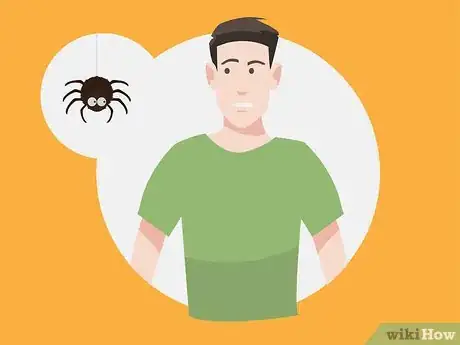
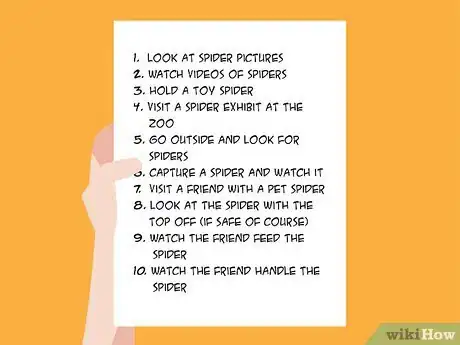

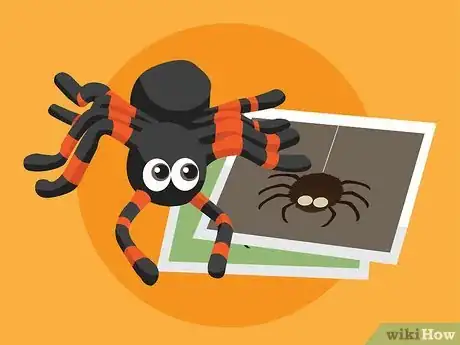

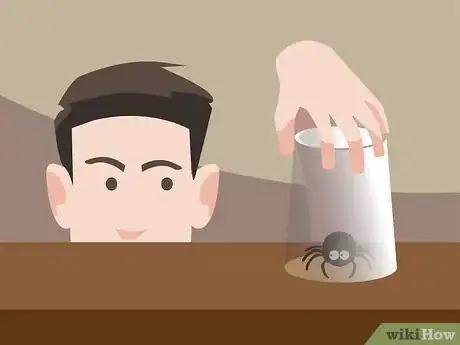



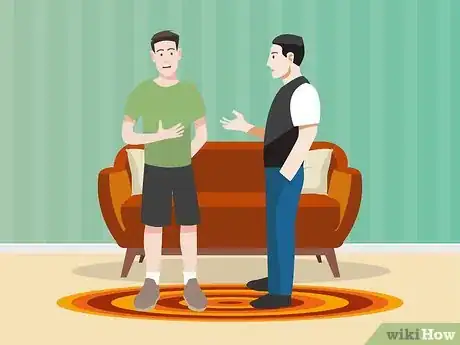



































































Medical Disclaimer
The content of this article is not intended to be a substitute for professional medical advice, examination, diagnosis, or treatment. You should always contact your doctor or other qualified healthcare professional before starting, changing, or stopping any kind of health treatment.
Read More...